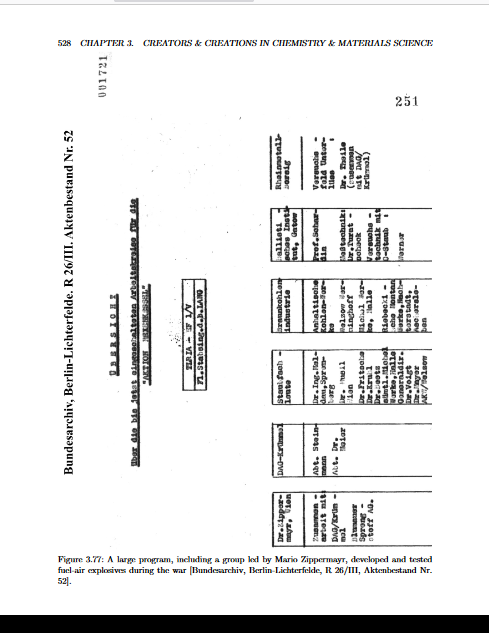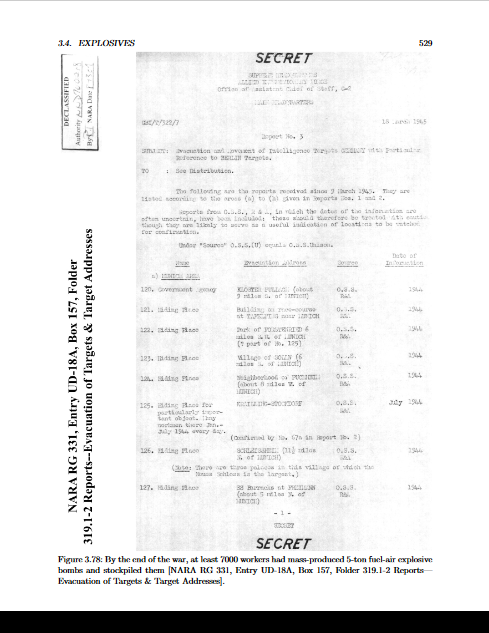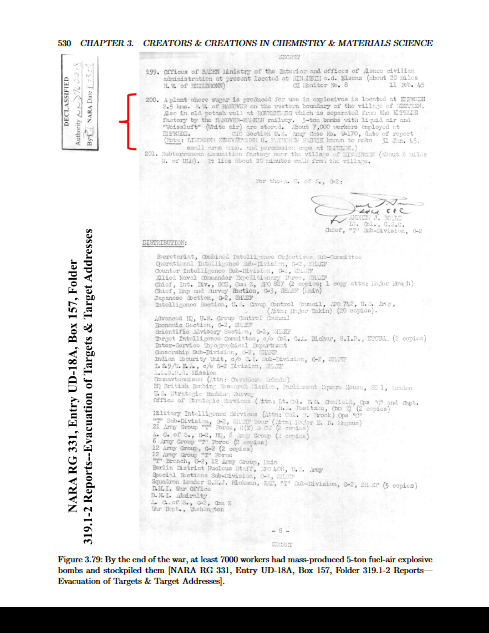More from Karlsch as quoted in Forgotten Creators concerning Zippermayr, Hexenkessel, and German FAE's (Fuel Air Explosives) in general:
"Even as late as the capitulation, the victors possessed only vague secret service information about the super bomb. Nevertheless, there was an interest in the immediate study and development of this technology, of course under conditions of utmost secrecy. For this reason, Zippermayr was repeatedly questioned by the Chemical Warfare Service, beginning on 3 August 1945. During a later interrogation in 1949, he told the Americans that with his bomb—whether with pulverized coal dust or with gas or other liquids—he could achieve the area destruction of a small atomic bomb. Furthermore, the production of such a bomb would be much cheaper. In contrast to other prominent German weapons industry researchers, there was reluctance to transport the SS man Zippermayr to the United States. However, several of his colleagues were offered the opportunity to continue their research in America in the context of “Operation Paperclip.” Apparently the Soviets also benefited from the knowledge produced by the Zippermayr group. According to an American report, Heinrich Mache, a professor at the Technical University in Vienna, was forced to conduct experiments with coal dust explosives in October 1945 under Soviet supervision.
The terrible fruits of the Zippermayr group did not just remain in the arsenals. They were used as “enhanced blast weapons” in the Vietnam War and in 1969 in Soviet-Chinese border conflicts at the Ussuri River. This name comes from the fact that the temperatures achieved by these bombs were not extreme. This changed in the late 1980s when the reaction temperature was raised substantially through added metallic particles, primarily aluminum, but also through other metals, as well as through oxygen. The principle of the thermobaric bomb, however, remained the same and is one example for the fact that it was not just in the case of missiles and jet planes that the victors in the Second World War made use of the knowledge of the defeated powers. That the technology behind the “father of all bombs” is old hat should not obscure the fact that this is a weapon of mass destruction that should be forbidden." (According to published sources, the present day Russian "FOAB" has a yield equivalent to 44 tons of TNT, which is low end battlefield nuke territory. - WP)
Dr. Rider:
"Note that the use of powdered aluminum in explosives to enhance the temperature and blast (as described above) was also developed in wartime Germany; see pp. 4186–4189 [BIOS 27; BIOS 100; BIOS 1261]. Thus the “thermobaric” and “enhanced blast weapons” built by the United States and other countries after the war were entirely derived from technologies that had previously been designed and demonstrated in Germany and Austria, based on information and materials obtained from German-speaking scientists, as well as the direct assistance of many of those scientists themselves (as shown below). An August 1949 JIOA document, Immigration of Austrian Scientists to Soviet Zone, listed several key members of Zippermayr’s team [NARA RG 319, Entry A1-134A, Box 31, Folder 02/006 430]:
FRITSCHE, Doz. Dr. Ing. Volker, Technische Hochschule, Vienna. Formerly with the Zippermayr Laboratory engaged in research in use of coal dust as antiaircraft explosive. Member of the Electro-technical Institute, Technische Hochschule. Reportedly making survey for Russians on high frequency prospecting for oil.
HOENIG, Dr Alfred, Scheffsnoth 8, Zell am See, Austria. Formerly worked at Zippermayr Institute engaged in research on coal dust explosives. Chemical Corps and Air Corps interestd. Chemical expert interviewed subject and ZIPPERMAYER, and agreed that their theories were basically sound and could not be permitted to reach potential U.S. enemies. It will be recommended that these two with KILLIAN be employed in U. S. HOENIG fears that he might be kidnapp[blacked out]
KILLIAN, Karl, Hattlegasse 40, Hitzing, Vienna XIII, Austria. Mathematician and aerodynamics expert who formerly worked with ZIPPERMAYER and HOENIG on Pfeil aircraft, torpedoes designed to be released from great heights and torpedoes with luminous underwater trails. Being considered along with HOENIG and ZIPPERMAYER for employment in U. S. by Chemical Corps.
MACHE, Prof. Dr. Heinrich, Pokenvgasse 25, Vienna XIX/117. Professor at Technische Hochschule, Vienna and regular member of Austrian Academy of Science. In October 1945, conducted experiments with coal dust explosives under Soviet orders. Specialist on discharge of electric energy in gases.
ZIPPERMAYR, Prof. Dr. Mario, Lofer Au 3, Zell am See, Austria. Stateless. Chemist. NSDAP member and SD from 1937 to 1945. Headed Zippermayr [blacked out] in coal dust explosives. [blacked out]. See HOENIG and KILLIAN.
BE[ETZ?], Dr.—Halle, Germany. Formerly with Zippermayr Institute engaged in research on methods of transmitting course of enemy bombers to night fighters and on dust explosions.
MELDAU, Dr. Ing—Last reported at Spremberg, Germany. Formerly with Zippermayr Institute engaged in research on coal dust explosives.
Zippermayr and some of the other scientists were extensively interrogated after the war, and some were taken to work for the United States, Russia, or other countries. As shown in Fig. 3.77, Zippermayr’s Austrian group was part of a much larger wartime program to develop, test, and mass-produce fuel-air explosives. By the end of the war, at least 7000 workers had mass-produced 5-ton fuel-air explosive bombs and stockpiled them (Figs. 3.78–3.79). Those stockpiled bombs were presumably taken by Allied countries. There were several reports of successful tests of fuel-air explosives during the war. Some archival documents even mentioned unconfirmed reports of a few cases in which fuel-air explosives were apparently actually used on the Eastern front during the war. Much more historical research on this topic could be quite enlightening."



